
4 Fun Activities For You and Your Child with ADHD
If you have a child who has been diagnosed with ADHD, you know one of the main symptoms is hyperactivity. In other words, your child may seem to have an excess of energy, and all of that energy needs to be channeled.
Unfortunately, modern kids are far less physically active than kids from just 20 years ago. It used to be natural for kids to be outside running around and riding bikes, but many of today’s kids spend their time sedentary, watching television, and playing video games.
Clinical psychologists and psychotherapists are taking note of this change and expressing concern. Roberto Olivardia, Ph.D, a clinical psychologist and clinical instructor in the department of psychiatry at Harvard Medical School has said, “Being outside provides ADHD children with a more open environment to appropriately express their energy.”
And psychotherapist Terry Matlen, ACSW, agrees, “Children who are hyperactive and impulsive can release tension far easier being outside running, jumping, swinging, and playing sports than sitting indoors.”
If you want to help your child to be more regulated, help them get their body moving. As a bonus, all of this physical movement will help your child improve their balance, coordination, and other gross motor skills.
Here are some fun activities you can enjoy with them.
Riding Bikes:
Not only is bike riding a terrific aerobic exercise that is gentle on growing bones and joints (as well as aging bones and joints!), it’s a great way to explore your neighborhood or local community. When we drive by places in our cars, we tend to overlook many of the details and things that make our local communities special. But when we ride our bikes, we can take in much more.
Family Sports:
If you’re lucky enough to have family members nearby, consider having a weekly family team sporting event. This could be family soccer games, touch football games, softball games, or whatever you come up with. Make the prizes fun, like losers cook winners’ dinner or losers mow winners’ lawn.
Yard Work:
Speaking of mowing the lawn, having your kids help out with yard work can be a great way to spend time together while getting important tasks accomplished. Painting fences, raking leaves, and hauling things in the wheelbarrow are great ways for your kid to release energy. Plus, when you’ve completed a project together, your child will feel a sense of pride and accomplishment.
Treasure Hunt:
Whether it’s in your backyard, at the local park, or in a forest at the end of town, a treasure hunt is a creative way to get your kid exploring in the great outdoors, moving their body, and having an awesome time. Your treasure hunt could have an educational theme, like finding and solving math problems to get the next clue or learning about American Presidents with each treasure found.
Kids with ADD/ADHD are constantly being told to calm down and sit still. So getting them outdoors where they can move their bodies and explore will not only calm them, but will also make them feel better about themselves.
If you or a loved one has a child that has been diagnosed with ADD/ADHD and would like to explore treatment options, please get in touch. I would be more than happy to discuss how I may be able to help.
Learn More
The Importance of Diagnosing Autism
Autism Spectrum Disorder (ASD) is a developmental disorder that results in repetitive behaviors, social interaction and communication challenges, as well as challenges with sensory processing. The word “spectrum” is aptly used to reflect that symptoms can vary greatly, from mild to severe, across different individuals.
In a study by the Centers for Disease Control and Prevention (CDC), 1 in 59 U.S. children were identified as having ASD. The earlier the disorder is diagnosed, the sooner a child can be helped through treatment interventions.
ASD Symptoms
The symptoms of Autism Spectrum Disorder include:
· Trouble with basic human communication. This can include a lack of responsiveness during social interactions, abnormal use of gestures, eye contact or facial expressions and a difficulty understanding relationships.
· Repetitive behaviors and interests that can include specific movements or spoken phrases, a need for routine, intense interest in specific objects or topics, and either low or high levels of sensitivity to sensory environment (sights, sounds, smells).
· Symptoms present early in childhood and cause “clinically significant impairment in social, occupational, or other important areas of current functioning.”
Diagnosing ASD
As stated earlier, it’s important that ASD be diagnosed as early as possible to reduce the symptoms of autism and improve the child’s quality of life. There is no medical test for autism. Instead, diagnosis is based on observing the child. Trained professionals are usually able to diagnose autism by speaking with the child and asking questions of parents and other caregivers.
The American Academy of Pediatrics recommends that children be screened for developmental disorders before the age of three. Here are some possible red flags for autism spectrum disorder that the Centers for Disease Control has identified:
· Not reacting to his or her name by the age of 12 months.
· Not acknowledging objects to show interest by 14 months.
· Not playing “pretend” games by 18 months.
· Isolating themselves and not making direct eye contact.
· Getting upset by minor changes to routine.
· Repetitive motions such as spinning in circles, rocking their body or flapping their hands.
If your infant or toddler has shown any of these symptoms and you have concerns about their development, it’s important that you bring them to your family physician for evaluation. While there is no cure for Autism Spectrum Disorder, there are different styles of therapy, such as Occupational Therapy that can lesson symptoms and improve the child and their family’s quality of life.
SOURCES:
https://www.psychologytoday.com/us/conditions/autism-spectrum-disorder
https://www.psychiatry.org/patients-families/autism/what-is-autism-spectrum-disorder
https://psychcentral.com/autism/
Learn More